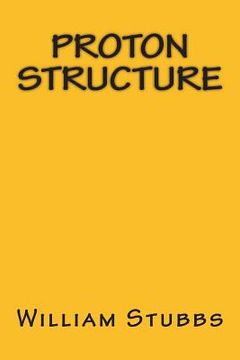Reseña del libro "Proton Structure (en Inglés)"
Proton Structure reexamines the original deep inelastic scattering data generated by the Stanford Linear Accelerator Center (SLAC) in the late 1960s and early 1970s. It shows that the proton and the deuteron structure functions appear to peak at a proton momentum fraction of 1/9. This indicates that the proton (and the neutron) is made of nine particles. Based on their masses and charges, it proposes that those particles are four muons and five antimuons. Proton Structure then examines the proton structure function further using data generated by the Hadron Electron Ring Accelerator (HERA) in 1993. The HERA electron scatterings occurred at energies significantly higher than the ones in the SLAC experiments. This provided a much higher resolution of the inside of the proton. Proton Structure analyzes the HERA data for momentum fraction less than the SLAC peak value of 1/9. It shows that the HERA data actually produces a structure function curve for the muons inside the proton.The structure function curve for the muon peaks at a muon momentum fraction of 1/203. This indicates that the muon is made of 203 particles. Based on their masses and charges, Proton Structure proposes that the muons inside the proton are made of 102 electrons and 101 positrons. The antimuons are made of 101 electrons and 102 positrons. Free muons are made of 104 electrons and 103 positrons; and free antimuons, 103 electrons and 104 positrons.Proton Structure notes that the SLAC structure functions, which revealed the muons, peak at about 1/3 instead of 1. It shows this indicates the muons and antimuons inside the proton configure themselves in clusters of three. Proton Structure calls these clusters trimuons and discusses two types found in the proton. Positive trimuons are made of one muon and two antimuons. Negative trimuons are made of two muons and one antimuon.Proton Structure proposes that the muons and antimuons in a trimuon bind together by sharing electrons and positrons. A free muon is made of 207 electrons and positrons, but a muon inside a proton only 203. Proton Structure proposes that each muon and antimuon inside a proton shares enough electrons and positrons with its neighbors to possess 207. Sharing electrons and positrons makes the muons and antimuons inside the proton feel like free particles, even though they are not. To keep that feeling, the muons sharing particles must stay together, so a bond forms between them. It creates a mass defect similar to that seen in binding of nucleons.Proton Structure then proposes that the three trimuons bind together to form the proton. The bound trimuons form a tripod-like configuration, with three legs. A muon and an antimuon at the end of each leg provide particles for muons and antimuons from other protons to bind to using the electron sharing mechanism. Proton Structure proposes that the neutron is the same as a proton, but contains two additional electrons and one additional positron in one of its muons. These are rogue particles. Eventually, the positron and one of the electrons annihilate, pushing the other electron out of the muon, leaving a proton.Proton Structure suggests two types of bonds may form between nucleons, the single bond and the double bond. In a single bond, a muon from one proton shares two electrons and two positrons with an antimuon from another proton. Single bonds create a mass defect of four electron masses. In a double bond, the muon and antimuon at the end of one leg of a proton each share two electrons and two positrons with the antimuon and muon at the end of a leg of another proton. Double bonds are essentially two single bonds, and create a mass defect of eight electron masses. With these bonds and the proton and neutron models, Proton Structure offers models of the deuteron, triton, helion and alpha particle. The masses of these models compare to the measured values to within four electron masses or better.

